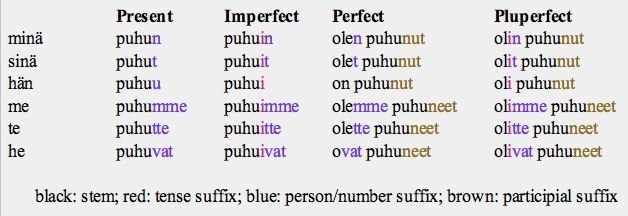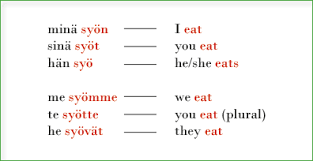The conjugated verb has three components: stem, tense or mood suffix, number/person suffix. There is only one conjugation for all Finnish verbs. The positive conjugation is paralleled by a negative one.

The negative marker is conjugated for person and number. The use of a separate personal pronoun, before or after the verb, is optional for the first and second persons but compulsory for the third (except in the imperative).
•person and number: first, second and third persons, singular and plural, plus a fourth-person for indefinite subjects.
•tense: primary tenses are the present and the imperfect . Compound tenses are the perfect and pluperfect formed with the auxiliary olla (‘to be’), conjugated for person and number, plus a past participle inflected for number. There is no specific future tense though the present may function as such.
The present indicative has no tense suffix. The imperfect uses the tense suffix -i and the marker of the 3rd person singular is zero. As an example we show below the conjugation of the verb puhua (‘to speak, to talk’):

•mood: indicative, potential, conditional, imperative. The potential and the conditional each have one primary form and one compound form made by combining an auxiliary verb and a past participle. The conditional perfect uses the auxiliary olla (‘to be’) and the potential perfect the cognate liene (‘might be’). The potential is little used nowadays in the spoken language and is loosing ground in written usage as well. The imperative has also compound forms but they are rarely used. The potential mood suffix is -ne and in the conditional -isi.

•voice: active and passive-impersonal. All verbs, either transitive or intransitive, can occur in the passive-impersonal voice. In the colloquial language one of its main functions is to express the 1st person plural imperative. In the literary language it is used to express impersonal general statements (as on in French and man in German).
•non-finite forms: infinitives, present participle (active and passive), past participle (active and passive). Some of them are inflected for number, case, and possession. There are several infinitives:
Infinitive I has two forms. The invariable short infinitive is the citation form in the dictionary and is similar to the English infinitive. The long infinitive is in the translative case and marked for person and number; it expresses purpose.
Infinitive II may also take personal markers and has inessive and instructive forms which express simultaneity and manner of action, respectively.
Infinitive III may be used after a coverb adopting the illative, inessive, elative, adessive or abessive cases. In the inessive case, jointly with the coverb olla, it expresses continuity of action. In the illative, denotes that an action is about to take place. In the elative, usually conveys separation. In the adessive, indicates the means by which an action is performed. In the abessive, it shows that an action does not take place.


